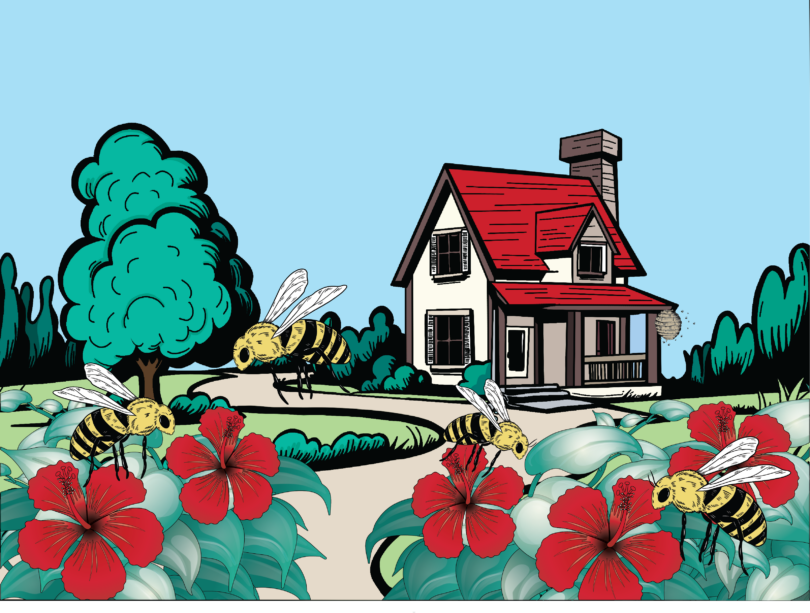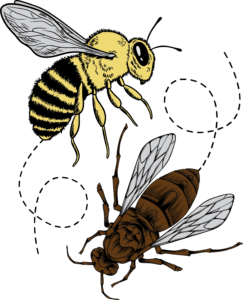What’s the difference between bees and wasps?
With more than 20,000 species of bees worldwide, it’s nearly impossible for the average person to differentiate between each one. Carpenter bees, honey bees and bumblebees come in a variety of sizes, shapes, and patterns, but the one thing they have in common is that these busy insects pay far less attention to you than you do to them.
“The last thing bees want to do is sting you,” says Keith S. Delaplane, the director of the University of Georgia’s Bee Program. “Most of the time, they don’t even know you’re there. If you’re sitting on your patio, one might come and land on you for a bit and then move on. When you start swatting, you’re giving them a moving target. You’re telling them that danger is near.”
It may be hard to believe that when you’re constantly dodging them at your summer barbeque but, while bees are sometimes attracted to your fruit salad or lemonade refresher, they mostly seek out flowering plants. That, says Delaplane, is the main behavioral difference between bees and wasps. Wasps, including hornets and yellow jackets, are carnivores, and that explains why they can be more of a nuisance than bees. Bees, on the other hand, are total vegetarians and only eat plant nectar and pollen.
“It makes a big difference in fall when wasps are foraging. For example, yellow jackets will start causing mischief during tailgate season. They’ll fly around your grill trying to steal hot dogs and burgers,” Delaplane says.
There’s also a big difference between a sting from a wasp versus a bee. Yellow jackets sting to kill or paralyze their prey. Afterward, they take their catch back to the nest, chew it up and feed it to their young.
“Wasp venom has more protein enzymes because they’re hunting rather than gathering,” says Delaplane. “If you get stung by both, you’ll come to appreciate that the sting of a hornet is a lot more painful than the sting from a bee.”
How to Avoid Getting Stung
The thought of being stung when encountering a bee or wasp can send many people into a panic (especially those with an allergy), but stings are largely avoidable once you learn more about how these insects live and behave.
Most bee species do not live together in hives or colonies like we think. They are solitary and live in single tunnels in the ground. These tunnels can cluster together in patches, giving the false appearance of a colony. For a few days each spring the ground shimmers with bee activity. But even during these active spells the chance of stings is remote. Without a colony to defend, it makes more sense for a nesting bee to avoid trouble and fly away.
“You can walk through them like a boat parting water,” says Delaplane. “They’re totally harmless.”
The best way to prepare for these nests is by checking out your lawn before you mow or plan your next backyard get-together. In springtime, look out for holes in your yard. Delaplane describes them as “fairly big, a quarter or a half-inch in diameter with a little mound of dirt, easy to mistake for an anthill.” There may be hundreds of them in a small area. Delaplane suggests leaving them alone for a couple of weeks and they’ll probably be gone for another year. Meanwhile you’re getting free pollination for your garden!
It’s a different story with yellow jackets, however. These social wasps live together in colonies and if their nest is disturbed, they will vigorously defend it. The way to tell them apart from soil-nesting bees? Bees pepper the ground with dozens, maybe hundreds, of individual holes whereas yellow jackets come and go from a single entrance, often an inch or two in diameter. Learn to be on the lookout for these holes and avoid disturbing them.
But even for yellowjackets, Delaplane advises restraint. Wasps of all kinds are an integral part of a complex ecosystem, starting in our backyards. Though most people know that bees are important pollinators, Delaplane describes wasps as the most important controllers of garden pests. They feed on caterpillars that destroy garden crops, tomato hornworms, and aphids. So, if you’re a home gardener, wasps might be your best friend. And for anyone who tires of hearing the cicadas screaming through the summer, it may help to know that their native predator is a wasp called the eastern cicada killer.
Carpenter Bees and Honey Bees
When it comes to carpenter bees, stingers are the least of a homeowner’s worries, but Delaplane has insight into the most common myth about these “wood bees.”
“Carpenter bees don’t actually eat wood,” he says. “They’re not like termites. They burrow in solid wood just enough to make tunnels where they can raise their babies. Believe it or not, they generally do not cause serious structural damage.”
Delaplane explains that carpenter bees prefer thin wood like cedar siding and love exposed construction timber like you find in your ceiling joists, garage rafters, and deck. While the territorial male carpenter bees act aggressively, chasing females and chasing away other males, they don’t have stingers, so feel free to gently shoo one away if it gets too close. How do you tell a sting-less male apart from a stinging female? Males have yellow patches on their faces. But as with other solitary bees, even the sting-capable females rarely sting.
Carpenter bees aren’t the only ones trying to move in with you this summer. A growing issue among homeowners is honeybee colonies that are nesting in their walls.
Honeybee colonies reproduce by splitting. They birth a new queen and then the original queen and about half of the workers fly away to look for a new vacant cavity. Their natural habitat is old-growth hollow trees but nowadays there aren’t enough to go around. Unfortunately, they look for the next best thing, which may be the gaps in your home’s exterior wall.
Delaplane says that if you notice a lot of bee activity around your house, chances are it’s a honeybee colony that is scouting out a new home. If you get there early enough, you can close the gap so they can’t get in. If you get there too late, the bee expert advises calling a professional to physically open your wall and cut out the combs.
“If you try to do it yourself and just spray in an insecticide, the combs will melt and that, mixed with all the dead bees, will make your house smell like a dead animal,” says Delaplane.
How do you know if they’re scouts or if they’ve moved in permanently? Delaplane has an easy tip.
“Watch them as they come and go and see if they have little yellow balls of pollen on their legs. If they do, that means they’ve already set up housekeeping and they’re feeding the rest of the colony. That’s when it’s time to call the experts.”







